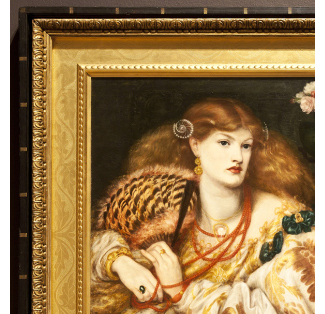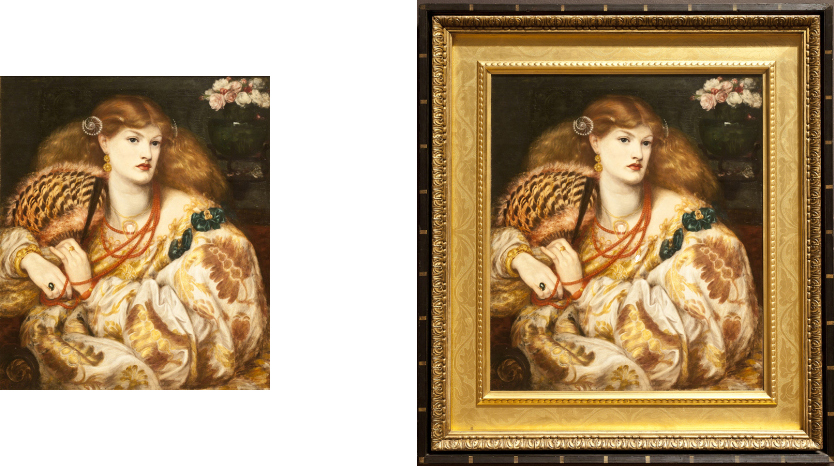Pre-Raphaelite Victorian Avant-Garde
Tate, London to NGA, Washington 2013
Pre-Raphaelite painters rejected the mass produced composition frames that were the norm during the early part of the 19th centuryEngland and embraced the notion that the frames should work as an extension of their paintings. Thus they were very involved in the design and construction of the frames for their work and developed modern styles modifying favorite models from the past. The frames often had symbolic carvings and inscriptions that reinforced the meaning of the story in the paintings. Since the paintings were hyper-realistic and illustrative they needed the relief of a flat panel, liner or spandrel so the cassetta style of Florentine frames was often the template.

An example of the early frames of this period is the John Everett Millais for “Convent Thoughts” 1848 pictured above. It is a simple spandrel with arch, adorned with lilies and calligraphic title.

The frame on William Holman Hunt’s “The Awakening Conscience” is a very fine example of earlier designs made modern. He used an Italian frame with a flat panel decorated with bells and marigolds. These are emblems of warning and sorrow, the star at top center that casts a “redeeming” light. Notice that the bottom panel is not decorated but instead has an inscription and resembles a threshold with which to lead you into the painting.
The summertime further is a superior period to receive a head start in the university software tactic. Because the rivalry for your favorite school can be hard, lousy scores may be the one that may shut the doorway in your school program to write my paper. Finally, you happen to be going to modify your article. Writing a college admission essay differs from an overall essay. Make your article gay and exciting. The dreaded college essay is the most problematic with reference to really coming up as well as a matter to come up with.
Essay visitors have an interest in locating informative writing.

The most distinctive and elegant frames were made by Ford Maddox Brown and Dante Gabriel Rossetti who were very much influenced by the Gothic designs of northern Europe.
Brown’s “Jesus washing Peter’s Feet”1866 is framed in an understated reeded molding with an inner panel of lap-joined oak, gilded without gesso to expose the wood grain. The incised rosettes are on the sides only with additional roundels set into the fluted molding. Finally there is a striking outer molding of stained black with stripes of gold.

The stunning frame on Gabriel Dante Rosetti’s “Madonna Vanna” 1866 is a similar format but instead of rosettes it has bands of discreet ornament. The flat panel is decorated with punch work leaves, the design of which is taken from the brocade in the dress.

William Holman Hunt was by far the most extravagant of the Pre-Raphealites in his use of elaborate frame designs. He continued to create remarkable and varied frames for over 50 years. The frame for “ Finding the Savior in the Temple” is totally unique. Again we have a basic cassetta style foundation but the top shows a stylized capital that surrounds an array of exotic patterns. This frame would seem to be a precursor to the Arts and Crafts movement of the late 19th century.

William Hollman Hunt’s last important frame for ‘The Lady of Shalott” circa 1905 is truly magnificent. Somewhat like an Italian tabernacle it has columns that support a capital and a base all beautifully decorated with vines, leaves and garlands. At the bottom is a funerary urn a forewarning of the Lady’s fate. At the top Pandora’s box with the word “Hope” hidden in the carving.
During the 1860s a second wave of Pre-Raphaelite artists emerged and although the earlier reeded with flat panel frames were still used it was Renaissance frames with extremely opulent decorations and shapes that became the favored pattern. This was perhaps because they suited the Victorian interiors and tastes of wealthy patrons of the late 19th century.

Sir Lawrence Alma-Tadema “On the road to the Temple of Ceres” 1879 displays a classic design of the tabernacle frame with a certain amount of reserve in that the ornament is understated. The use of clean burnished gold also gives the frame a modern flair. Alma-Tadema signed his frames thus elevating them to status of works of art in their own right.

The frame by artist Frederick Lord Leighton “The Bracelet” C1894 is a wonderful example of a scaled down aedicular surround with only a minimal amount of pattern. The pilasters are flat and very wide, topped with capitals in the Ionic style. The effect is to draw the viewer in as if entering though a doorway, into a private scene from another era.
The frames of the Pre-Raphaelites were very influential and have inspired artists and frame makers from their time forward. They adapted neoclassical designs and felt stromgly that frames should be an extension of the paintings they house. James McNeill Whistler, who was also a member of the Victorian Aesthetic movement developed his own simpler version of these frames leaving the panels plain or adding abstract motifs. These reeded frames are now known as “Whistler” frames. Buck’s County frame makers Frederick Harrer and Ben Bedura used similar Florentine shaped moldings but added carving to the corners and organic or geometric punch work to the panels.

The function of picture frames in the 19thcentury was considered primarily utilitarian and it was felt that art should be self-sufficient, the frame merely setting the painting apart from its surroundings. Also to draw attention to their work amidst the highly competitive gallery shows artists used excessively wide brightly gilded moldings. Although they were not the first to do so the Pre-Raphaelite artists embraced the notion that frames should be an integral part of the picture and continue the scene or story in the painting. They were very involved in the design and manufacture of the frames and shunned machine made moldings. Keeping with the Arts and Crafts movement they admired craftsmanship and hand done finishes.
It is unfortunate that in the exhibition catalogue the paintings are shown without their frames as this totally changes the viewing experience.
*For a more extensive article on this subject please see theframeblog.wordpress.com/2012/10/06/pre-raphaelite-frames
